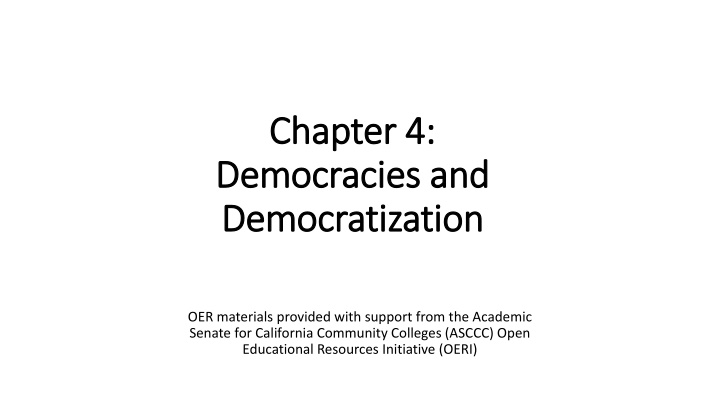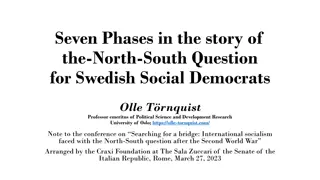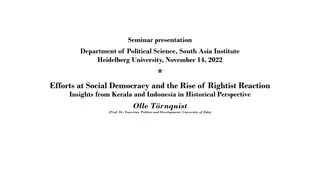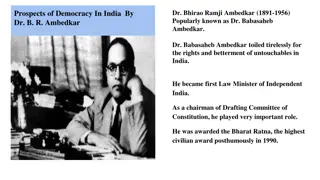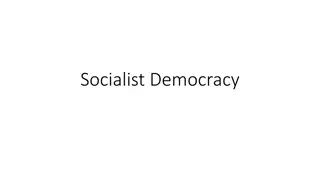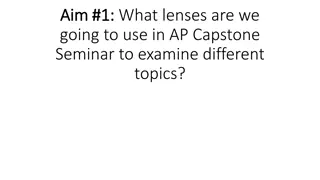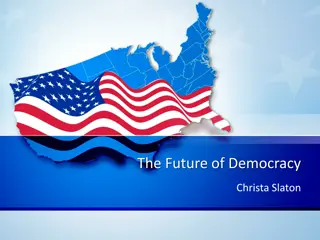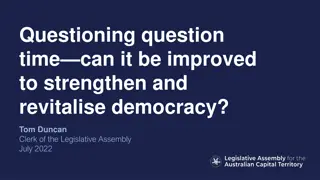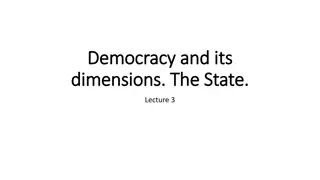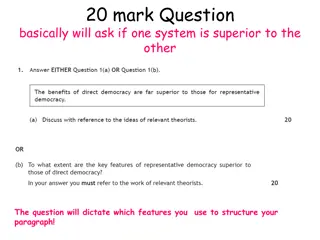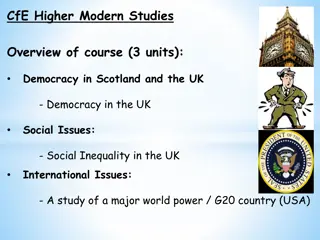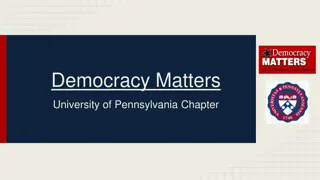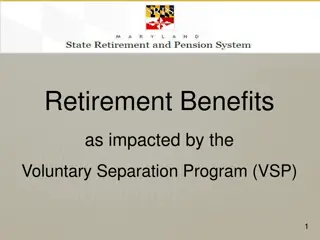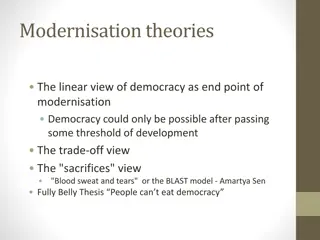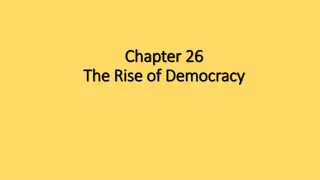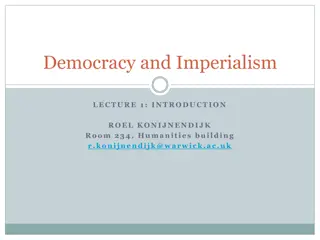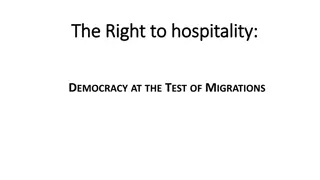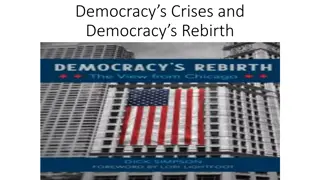Democracy: Power Vested in the People
Democracy, rooted in the Greek words for people and power, places supreme authority in the hands of the populace. Direct and indirect democracy models, alongside the importance of free and fair elections, shape the democratic process. Upholding standards pre, during, and post-elections ensures the legitimacy and integrity of democratic practices.
Download Presentation

Please find below an Image/Link to download the presentation.
The content on the website is provided AS IS for your information and personal use only. It may not be sold, licensed, or shared on other websites without obtaining consent from the author.If you encounter any issues during the download, it is possible that the publisher has removed the file from their server.
You are allowed to download the files provided on this website for personal or commercial use, subject to the condition that they are used lawfully. All files are the property of their respective owners.
The content on the website is provided AS IS for your information and personal use only. It may not be sold, licensed, or shared on other websites without obtaining consent from the author.
E N D
Presentation Transcript
Chapter 4: Chapter 4: Democracies and Democracies and Democratization Democratization OER materials provided with support from the Academic Senate for California Community Colleges (ASCCC) Open Educational Resources Initiative (OERI)
Chapter Outline Section #4.1: What is Democracy? Section #4.2: Institutions within Democracy Section #4.3: Systems of Democracy Section #4.4: Democratic Consolidation Section #4.5: Comparative Case Study South Africa & Iraq
Section #4.1: What is Democracy?
4.1 What is Democracy? Democracy is a government system in which the supreme power of government is vested in the people. Democracy comes from the Greek word, d mokrati , where demos means people , and kratos meaning power or rule.
4.1 What is Democracy? (Continued 1) A direct democracy enables citizens to vote directly, or participate directly, in the formation of laws, public policy and government decisions. Indirect democracy channels the power of the people through representation, where citizens elect representatives to make laws and government decisions on their behalf.
4.1 What is Democracy? (Continued 2) Free elections are those where all citizens are able to vote for the candidate of their choice. The election is free if all citizens who meet the requirements to vote (e.g. are of lawful age and meet the citizenship requirements, if they exist), are not prevented from participating in the election process. Fair elections are those in which all votes carry equal weight, are counted accurately, and the election results are able to be accepted by parties.
4.1 What is Democracy? (Continued 3) Ideally, the following standards are met to ensure elections are free and fair: Before the Election Eligible citizens are able to register to vote; Voters are given access to reliable information about the ballot and the elections; Citizens are able to run for office. During the Election All voters have access to a polling station or some method of casting their vote; Voters are able to vote free from intimidation; The voting process is free of fraud and tampering. After the Election Ballots are accurately counted and the results are announced; The results of the election are accepted / respected / honored.
4.1 What is Democracy? (Continued 4) Types of Democracy Liberal Democracies are those which facilitate free and fair elections, but also ensure the protection of civil liberties. An Electoral Democracy is a form of representative democracy where political leaders are elected through an election (electoral) process to exercise political power and manage the basic tasks of government operations. Flawed democracies are those where elections are free and fair, and basic civil liberties are protected, but issues exist which may hamper the democratic process. hybrid regimes, which are those where democracy is touted to exist, but elections may not be free or fair, and government functioning is poor. Illiberal democracies are those regimes where elections occur, but civil liberties are not protected.
Section #4.2: Institutions within Democracy
4.2 Institutions within Democracy Separation of powers is a term that divides government functions into three areas: the legislature, tasked primarily with the making of laws; the executive, who carries out or enforces these laws; and the judiciary, tasked with interpreting the constitutionality of laws. Electoral systems, simply put, are voting systems; an electoral system provides a set of rules that dictate how elections (and other voting initiatives) are conducted and how results are determined and communicated. Political Parties are groups of people who are organized under shared values to get their candidates elected to office to exercise political authority.
4.2 Institutions within Democracy (Continued 1) Legislative, Executive, and Judicial Branches The Legislative Branch is tasked with performing three main functions:(1) making and revising laws; (2) providing administrative oversight to ensure laws are being properly executed; (3) and providing representation of the constituents to the government. The Executive Branch is typically made up of a singular leader, a leader with an assistant (vice-president) or a small group of leaders who have institutional powers, and serves as both the head of government and the head of state. In their capacity as head of government, chief executives must run and manage the day-to-day business of the state. As the head of state, the chief executive must represent the country in the global arena, for formal gatherings to dictate policies as well as for ceremonial responsibilities. The Judicial Branch refers to the part of government where laws can be interpreted and enforced.
4.2 Institutions within Democracy (Continued 2) Electoral Systems Elections are the mechanism through which leaders get chosen around the world. Rules that are relevant to an electoral system can include those that lay out when elections occur, who is allowed to vote, who is allowed to run as a candidate, how ballots are collected and can be cast, how ballots are counted, and what constitutes a victory. Usually, voting rules are set forth by constitutions, election laws, or other legal mandates / establishments.
4.2 Institutions within Democracy (Continued 3) Electoral Systems Elections are the mechanism through which leaders get chosen around the world. Rules that are relevant to an electoral system can include those that lay out when elections occur, who is allowed to vote, who is allowed to run as a candidate, how ballots are collected and can be cast, how ballots are counted, and what constitutes a victory. Usually, voting rules are set forth by constitutions, election laws, or other legal mandates / establishments.
4.2 Institutions within Democracy (Continued) Political Parties Political Parties are groups of people who are organized under shared values to get their candidates elected to office to exercise political authority. Political parties can exist as both a label and to indicate group leadership; as a label, individuals label themselves and their core values/priorities when voted and political parties can be used to indicate a group of leaders acting on behalf of the party. Political parties are not altogether helpful in democracies, but can be mitigated by means of an extended political sphere. In other words, if factions must exist, it is better to have too many than too few.
Section #4.3: Systems of Democracy
4.3 Systems of Democracy The Presidential System of government, sometimes called a single executive system, is one where the head of government is a president who leads the executive branch of government. The executive branch of government, in this system, is separate and distinct from the legislative branch, to ensure a separation of powers. The Parliamentary System, sometimes called parliamentary democracy, is one where the chief executive, usually a Prime Minister, attains their role through election by the legislature. The Semi-Presidential System, sometimes called the dual executive system, is one where a country has both a president and a prime minister and cabinet.
Semi-Presidential Systems Presidential System Parliamentary System Semi-Presidential System Advantages 1. Fixed term 2. Popularly elected 3. Unipersonal leadership 1. Head of government is dependent on legislative approval 2. Easier to remove the head of government by legislative will 3. Collective leadership is present (with)in cabinet 1.For its parliamentary functions, Parliament has the ability to remove an unpopular prime minister, especially if the prime minister and the president are not working cooperatively 2. Division of work between prime minister and the president decreases the amount of bureaucracy. Disadvantages 1. Deadlock within executive branch of government 2. Temporal rigidity, fixed term, can t get them out easily (has never happened in US history) 3. Winner-take-all is an exclusive form of representative government, thus third parties are left with very little chance at victory 1. Instability in Head of Government 2. Head of Government is not elected directly by the people 3. No separation of powers per se between Head of government and Legislative body 1.Tends to favor the president, not the prime minister 2. Confusion over who is responsible for what 3. Potentially inefficient or ineffective legislative process
Section #4.4: Democratic Consolidation
4.4 Democratic Consolidation Democratic consolidation, is a type of regime transition whereby new democracies evolve from fledgling regimes to established democracies, making them less at risk to fall back into authoritarian regimes. When a democracy becomes consolidated, scholars expect that it will endure. A regime transition, according to comparative scholar Stephanie Lawson, is a substantial change in the form of governance of countries, involving shifts from one type of regime to another, such as a shift from a socialist to a democratic form of rule. Many scholars assert that democratic consolidation occurs when the regime transition to democracy has ended, and further, that the qualities that led to the regime transition may not be the same qualities required to make a democracy endure.
Section #4.5: Comparative Case Study South Africa & Iraq
4.5 Comparative Case Study: South Africa and Iraq Both South Africa and Iraq experienced journeys toward the destination of democracy, but with differing success in means and ends. While the countries of Iraq and South Africa differ in a multiplicity of ways, there remain viable similarities in the past and present of the two states which allow for a candid academic assessment of the reasons for and nature of the regime transitions.
4.5 Comparative Case Study: South Africa Colonial Rule. Nationalist and Ethnic Identities. Political Map of South Africa. (Source: Map of South Africa by CIA World Factbook is licensed under Public Domain)
4.5 Comparative Case Study: Iraq Rejection of European Rule. From Authoritarianism to Democracy. Current instability and difficulty in consolidation. Political Map of Iraq. (Source: Map of Iraq by CIA World Factbook is licensed under Public Domain)
4.5 Comparative Case Study: Summation 1.) Both states have a history of (European) British/Dutch colonialism and/or imperialism which has directly and indirectly influenced their current political realities & exigencies 2.) Both have 20th century history of minority rule over and oppression of the majority 3.) Both were ostracized, sanctioned and condemned by the international community during the middle-to-latter part of the 20th century 4.) Both were pressured to transition to new regimes by the United States 5.) Both experienced post-Cold War transitions 6.) Both are relatively new democracies 7.) Both now have constitutions that protect minorities, promote civil liberties and freedom of religion/press, establish an autonomous judiciary, limit executive power, confer pluralistic suffrage and support regular free, fair and transparent elections 8.) Both states have religiously & ethnically diverse, non-homogenous populations 9.) Both have significant external debt and high unemployment 10.) Both have vast natural resources and excellent economic potential
Summary 1. Democracy is a government system in which the supreme power of government is vested in the people. Democracy has a number of characteristics which can be central to understanding the variation in democracies that exist worldwide today. 2. While some elements and characteristics of democracy vary, one constant commonality is the separation of powers among institutions within governments. This separation of powers promotes checks and balances because it provides for power to be spread throughout multiple branches of government with the intention of splitting up power between institutions so that no single branch has too much power but instead empowering all branches with their own institutionalized powers. 3. The three branches of concern include: (1) the legislature; (2) the executive; and (3) the judiciary. 4. Within democracy, there are three types of systems which may be present, including: the presidential, the parliamentary and the semi-presidential systems. Each of these systems were designed to fit the context and cultures of their democratic systems, and each has their share of advantages and disadvantages. 5. Democratization, also referred to as democratic consolidation, is a type of regime transition whereby new democracies evolve from fledgling regimes to established democracies, making them less at risk to fall back into authoritarian regimes. When a democracy becomes consolidated, scholars expect that it will endure. 6. Both South Africa and Iraq experienced journeys toward the destination of democracy, but with differing success in means and ends. While the countries of Iraq and South Africa differ in a multiplicity of ways, there remain viable similarities in the past and present of the two states which allow for a candid academic assessment of the reasons for and nature of the regime transitions.
